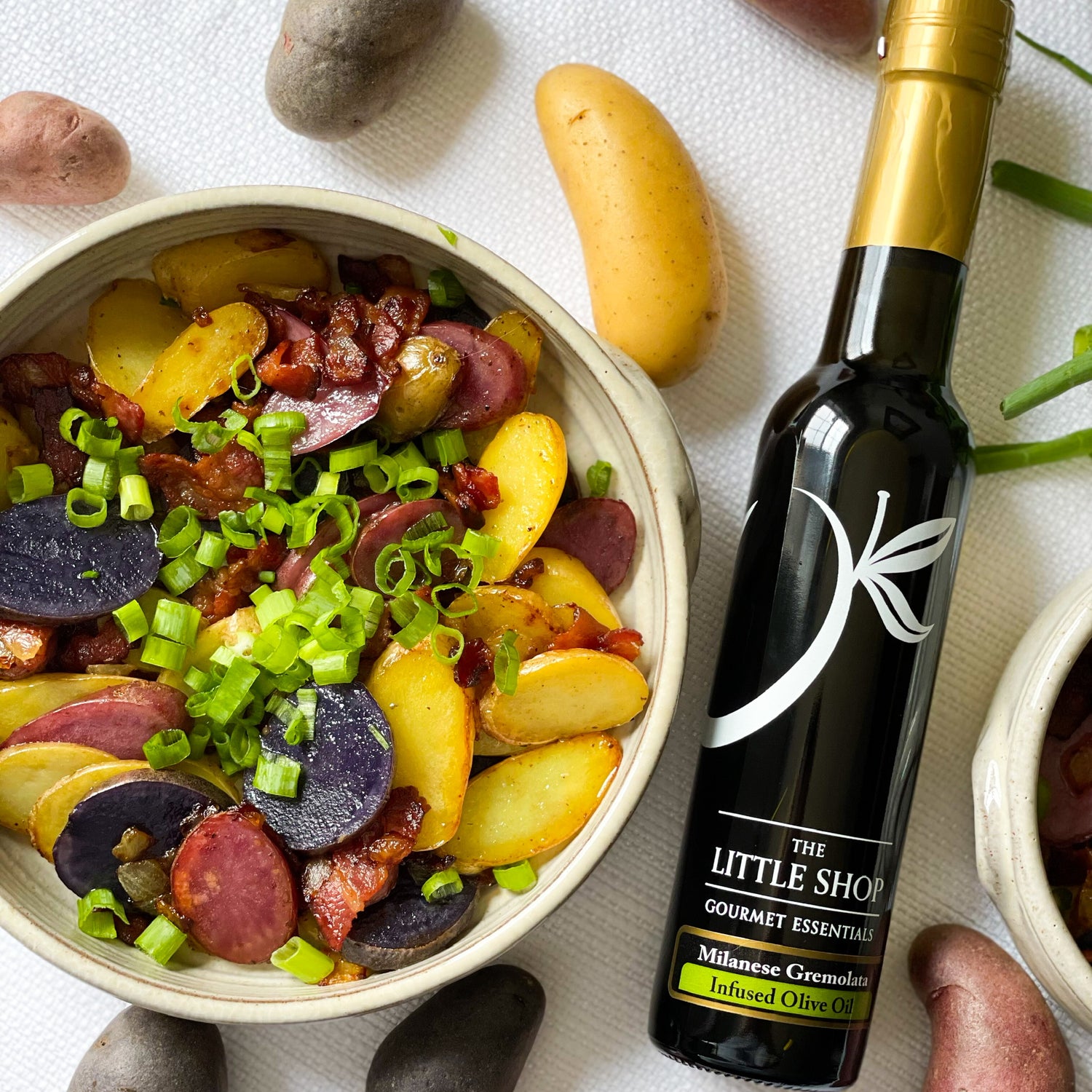The Measurement of Extra Virgin Olive Oil
Crush Date:
While many suppliers keep you guessing, we believe in full transparency. We proudly reveal the crush date on our ultra-premium extra virgin olive oil. We're talking freshness you can taste! For optimal health benefits, savor your EVOO within 14 months of its crush date. You can safely use your EVOO after 14 months if stored properly, but it won’t taste as vibrant and peppery as when you first opened the bottle. The older an olive oil is (especially if the bottle has been open), the more oxidation has occurred and the fewer bioactive compounds, including antioxidants, remain in the olive oil.
Oleic Acid:
This mighty component, a type of Omega-9 fatty acid, not only delivers health benefits but also acts as a superhero against free radicals, slowing down their damaging effects. Studies have shown various health benefits, including improvements to cholesterol levels, blood pressure and inflammation, along with decreased heart disease risk and the potential to improve both mood and cognition. The US FDA has approved the health claim that “Limited and not conclusive scientific evidence suggests that consuming about 2 tablespoons (23 grams) of olive oil daily may reduce the risk of coronary heart disease due to the monounsaturated fat in olive oil.” With higher levels of oleic acid, our olive oil stays fresher for longer, preventing the formation of rancid fats. It's a win-win for your health and taste buds!
FFA:
Following IOOC standards, EVOO can have a maximum free fatty acid (FFA) of 0.8g per 100g. Our selection of EVOO has FFA levels ranging from .12g to .29g. FFA reveals the fruit's condition at the time of crush, and higher levels indicate compromised fruit quality—think overripe, damaged, or insect-infested. Aim for a low FFA for superior quality! At The Little Shop of Olive Oils, we take pride in our swift process, harvesting and crushing within 4-6 hours or less. Taste the difference!
Biophenols:
Beyond its monounsaturated fatty acids, the health benefits of extra virgin olive oil are intertwined with its remarkable biophenol content. In the early days, biophenol levels were measured by their reaction with a colorant, but it failed to capture the nuances of different phenols and their specific properties. We now understand the significance of individual biophenol groups, like Oleocanthal with its potent anti-inflammatory action and the unique pungent sensation it imparts.
While international standards don't specify limits for polyphenols, their role as potent antioxidants in olive oil cannot be understated. They contribute significantly to oxidative stability, shelf life, and health benefits. To accurately measure these valuable compounds, we employ an advanced technique called High Performance Liquid Chromatography (HPLC). Through precise analysis, HPLC allows us to separate and identify compounds present in trace concentrations as low as parts per trillion, unveiling the true potential of polyphenols in our olive oils.
Extra virgin olive oil is a treasure trove of more than 20 diverse biophenols. These hydrophilic phenols come in various forms, including phenolic alcohols, acids, flavonoids, lignans, and secoiridoids. The latter two classes, rich in phenolic antioxidants like oleuropein derivatives, take center stage in our EVOO. Packed with incredible health benefits and distinctive pungent and bitter flavors, these phenols showcase antioxidant, anti-inflammatory, chemopreventive, and anti-cancer properties.
In 1996, the term "biophenols" emerged as a more accurate and encompassing name for the bioactive phenols found in olives and other plants. Today, biophenols have captivated researchers, industries, and health-conscious consumers alike, thanks to their widespread presence in plants and remarkable array of biological activities. From preserving food freshness to safeguarding human health, these versatile compounds showcase their potent antioxidative potential. As we delve deeper into the realm of nutrition, the notion of food as medicine gains traction, echoing the age-old wisdom of Hippocrates: 'Let thy food be thy medicine and medicine be thy food.' Biophenols, also known as polyphenols, stand at the forefront, showcasing their incredible ability to combat cancer, stroke, heart disease, Alzheimer's, and a host of other medical conditions.
Pyropheophytins (PPP)
Breakdown products of chlorophyll. Over time, chlorophyll breaks down first into pheophytins then into PPP, making PPP an excellent indicator of the age of an oil. Light and heat can accelerate the production of PPP.
DAGs (diacylglycerol)
Breakdown products of the fats. 1,2-DAG is high in well-made fresh olive oil from good fruit and 1,3-DAG is higher in olive oil made from poor quality fruit or oxidized or refined olive oils. The ratio between 1,2-DAGs and 1,3-DAGs declines steadily and is a good indicator of the age of an oil.
Organoleptic (sensory)
Analysis by a trained taste panel using official protocols is an important part of determining the grade of virgin olive oil. Taste panels identify and quantify defects and basic positive attributes in an olive oil. To be classified as extra virgin, an olive oil may have no defects in flavor, and must have fruitiness.
Peroxide value (PV)
A measure of peroxide compounds arising from primary oxidation. A high peroxide value usually indicates poor processing, and that the oil might not keep well. The final stage in oxidation is peroxide breakage, resulting in the formation of new compounds that we can perceive as rancid smelling.
Ultraviolet absorbency (UV)
An indicator of oxidation using the UV spectrum at different wavelengths. K232 is considered a critical marker for good quality extra virgin olive oil. Oxidation is the result of natural aging or indicative of poor handling or heating during the refining process.
A-Tocopherals:
Considered the silent hero that fortifies our well-being and empowers our body to thrive. Alpha-tocopherol, a coveted nutrient that operates in the shadows, yet its impact is profound. Soluble in fats and oils, it gracefully resides in nature's treasure troves—seeds, nuts, leafy green vegetables, and vegetable oils. This mighty chemical bolster our immune system and safeguarding against blood clots. With eyes set on the future, alpha-tocopherol steps into the limelight of scientific exploration, offering promising insights into cancer prevention and treatment. An antioxidant, championing our health on multiple fronts. Vitamin E.
Squalene:
Squalene is a remarkable organic compound that intertwines with our very own tissues. A polyunsaturated hydrocarbon with a molecular structure reminiscent of vitamin E, Squalene unveils its true magnificence. There are four additional clusters of isoprenoids that elevate Squalene to unparalleled heights of natural antioxidant might. This extraordinary synergy of compounds unveils a potent shield against oxidative stress, defending our cells from harm and nourishing our well-being. Step into the realm of Squalene, where science meets nature's brilliance, and the power of antioxidants reigns supreme.
Cold Press:
Imagine you're scrolling through your feed and you see another ad bragging about their "Cold Pressed" olive oil. Sounds fancy, right? But here's the thing, "cold pressing" is kinda like that song that's played way too much. Everyone talks about it, but it's not always clear what it really means. When they say "cold pressed," they're talking about how cool they keep the olives when they're squeezing the oil out. The cooler, the better, because it keeps all the good flavors and healthy stuff intact.
Now, you'd think there are strict rules about using the term "cold pressed," but it's the wild west out there. Technically, for an olive oil to earn the "cold pressed" badge, it's got to be made without heating it up over 86 degrees Fahrenheit. But, here's the catch: a lot of companies crank up the heat to get more oil out, which is great for them but not so awesome for the quality of the oil.
Our team does things differently. We keep it chill, literally, at about 70 degrees Fahrenheit. Sure, we end up with less oil than if we cranked up the heat, but the quality? Sky-high. Plus, there's this thing called the Malaxer – it's like a big mixer that stirs up the olive paste. How long the paste hangs out in there also makes a huge difference. Overdo it, and you might get more oil, but you're also dialing down on what makes the oil special.
So, when you hear "cold pressed," think about what's behind the scenes. We're all about keeping it cool to make sure our oil is not just more oil, but a blast of flavor and quality in every drop.

